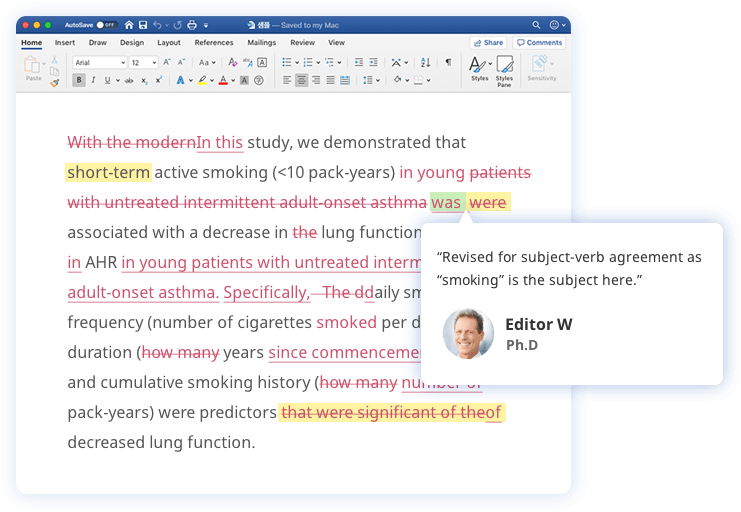ハイフンの使い方
ハイフンはいくつかの機能を持つ句読点です。ハイフンを使って複合形容詞を形成して名詞を修飾したり、句動詞を名詞に転換したり、また句形容詞と句形容詞を結び付けたりします。
内容が複雑だったり、専門用語がよく使われる媒体、例えば文学や新聞、または学術誌や科学研究などのアカデミックな文書を読んでいると、ハイフンが頻繁に使われているのを目にします。
ハイフンとダッシュは別物ですので混同しないよう注意してください。ハイフンは2つの語をつなげて1つの複合語にする一方、ダッシュは、センテンスの流れの切り替えや、文節の挿入のための中断の際に使われます。
複合形容詞に使うハイフン
複合形容詞は、名詞を修飾するために2つの語を繋げて形成し、1つの形容詞としての働きをします。複合形容詞が、修飾する名詞の前にくる場合にのみ、複合形容詞の形成にハイフンを使います。修飾する名詞の後に複合形容詞がくるときにはハイフンでつなぐ必要はありません。
修飾する名詞の前にくる複合形容詞はハイフンでつなぐ
- Example
- The hyper-competitive nature of the financial industry has led to the proliferation of white-collar crime and the lack of well-intentioned financial advisors.
修飾する名詞の前にくる複合形容詞でもハイフンでつながないケース
副詞(-ly)と形容詞から成る複合形容詞はハイフンでつなげません。
- Incorrect
- One overly-saturated area of finance is debt consolidation, which targets mostly-young debt holders such as college students.
- Correct
- One overly saturated area of finance is debt consolidation, which targets mostly young debt holders such as college students.
修飾する名詞の後にくる複合形容詞はハイフンでつながない
修飾する名詞の後にくる複合形容詞はハイフンでつなぎません。
- Incorrect
- Plagiarism in online articles is becoming all-too-common.
- Correct
- Plagiarism in online articles is becoming all too common.
句動詞を名詞として用いるためのハイフン
句動詞というのは、主となる動詞の後に1つ以上の副詞や前置詞といった語がつけられたタイプの複合動詞を指します。動作を表す句動詞についてはハイフンは要りませんが、名詞として用いられる句動詞の場合にはハイフンでつなぐか、または1つの言い回しとする必要があります。
| 動作を表す句動詞(ハイフン必要なし) | 名詞として用いられる句動詞(ハイフンでつなぐ/一つの言い回し) |
|---|---|
|
The teacher had to boot up his computer. |
The boot-up took longer than usual. |
|
The dealer will bring in the chips to the game. |
The poker player had to pay the bring-in. |
|
The fund manager tried to break down the cash statement. |
The trading floor listened to the daily breakdown on the news |
|
The trader was not the only one to mix up the order. |
The boss had to stay late to solve the mixup. |
今すぐネイティブ専門校正者の英文校正を通してフィードバックを受け取ってください。

- 学術論文
- 留学志望動機書
- 英文履歴書
- 事業計画書
- ブログ、ウェブサイト
- 大学課題、自由英作文
接頭辞と接尾辞につけるハイフン
英語では名詞のほとんどに接頭辞を付けて変化させることが可能ですので、ハイフンに関するルールは状況により異なります。
大まかにいうと、大文字、数字、日付の前に接頭辞を付ける際には常にハイフンでつなぎます。
ハイフンでつなぐのが一般的な接頭辞の例
- Example
- Most anti-bacterial soaps are effective at killing germs.
- Example
- The self-service counter was very popular with customers.
- Example
- He hadn’t seen his ex-girlfriend in many years.
ハイフンを付けても付けなくてもよい接頭辞の例
| ハイフンを使用しない接頭辞 | ハイフンを使用する接頭辞 |
|---|---|
|
The celebrity signed the autograph. |
The student was on auto-pilot all day. |
|
The scientist used the microscope. |
The micro-scale model was too small. |
|
The employee was proactive in finishing work. |
The official was very pro-government. |
|
The nonprofit organization helped sick children. |
The foundation became non-profit after getting a grant. |
常にハイフンでつなぐ接頭辞の例
- Example
- The Egyptian sculpture dated back to pre-1200 BC.
- Example
- The mid-December time period is hectic due to Christmas.
- Example
- The post-WWII period was one of great economic growth.
ハイフン付き(ハイフネート)複合語
ハイフン付き複合語とは、複数の語がハイフンでつながれた用語のことです。学生や研究者、また専門職の方はハイフン付き技術用語をよく目にすると思います。その他、家族関係や職業的地位などを示す用語にもハイフン付き複合語がよく使われています。
ハイフン付き複合語の例(技術用語)
- Example
- The strength-to-weight ratio needs to be increased.
- Example
- The phase-contrast microscope will be delivered soon.
- Example
- The researcher used Python to analyze the time-dependent variable.
ハイフン付き複合語の例(家族関係や職業的な地位)
- Example
- Her father-in-law did not appreciate her cooking.
- Example
- The editor-in-chief rejected the headline.
意味の明確化のためのハイフン
ハイフンは意味をより明確にしたり、曖昧さを回避する目的で使うこともあります。
| ハイフン付き/ハイフン無し 用語 | 意味 |
|---|---|
|
The worker decided to resign her contract. |
The worker did not renew her employment. |
|
The worker decided to re-sign her contract. |
The worker did renew her employment. |
|
His wallet had twenty five dollar bills. |
$100 total in bills. |
|
His wallet had twenty-five dollar bills. |
$25 total in bills. |
|
He just saw a man eating chicken. |
He saw a human male eating some chicken. |
|
He just saw a man-eating chicken. |
He saw a monstrous chicken that eats humans. |
ハイフンとダッシュの違い
ダッシュはセンテンスの流れの切り替えを意味したり、文節挿入のための中断の際に使う句読点です。
センテンスの流れの切り替え箇所の表示や、その前にくるセンテンスをさらに展開させる、または解説するのがダッシュを使う最も一般的な目的です。 また、スペースに限りがある際、単語と単語をダッシュで区切ったりもします。例えば、学術誌やレポート、または新聞など、用語が幅の狭い紙面に表示されるような書式でもダッシュを使うことがあります。









